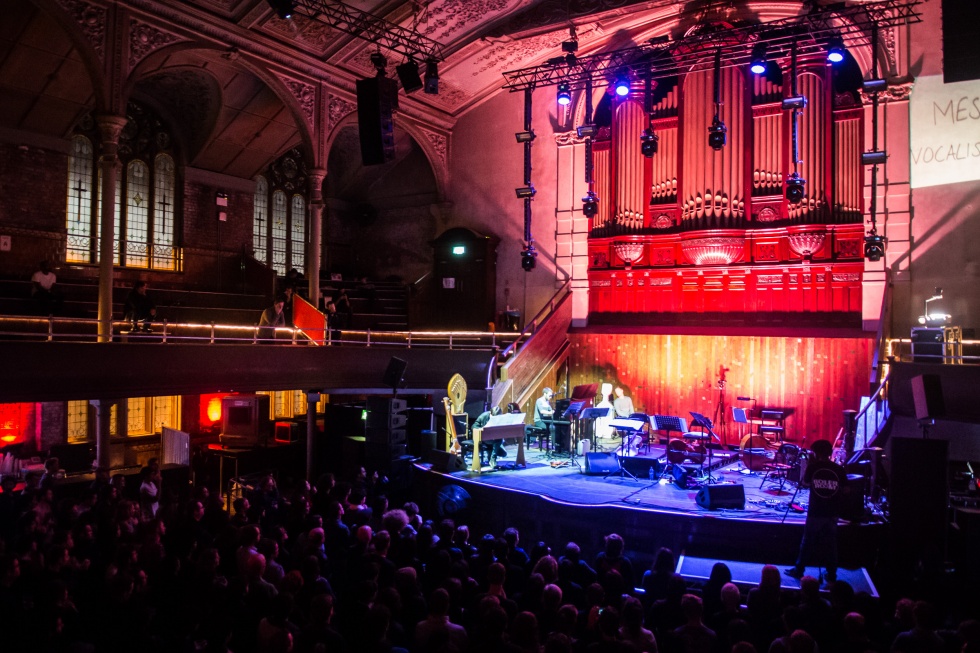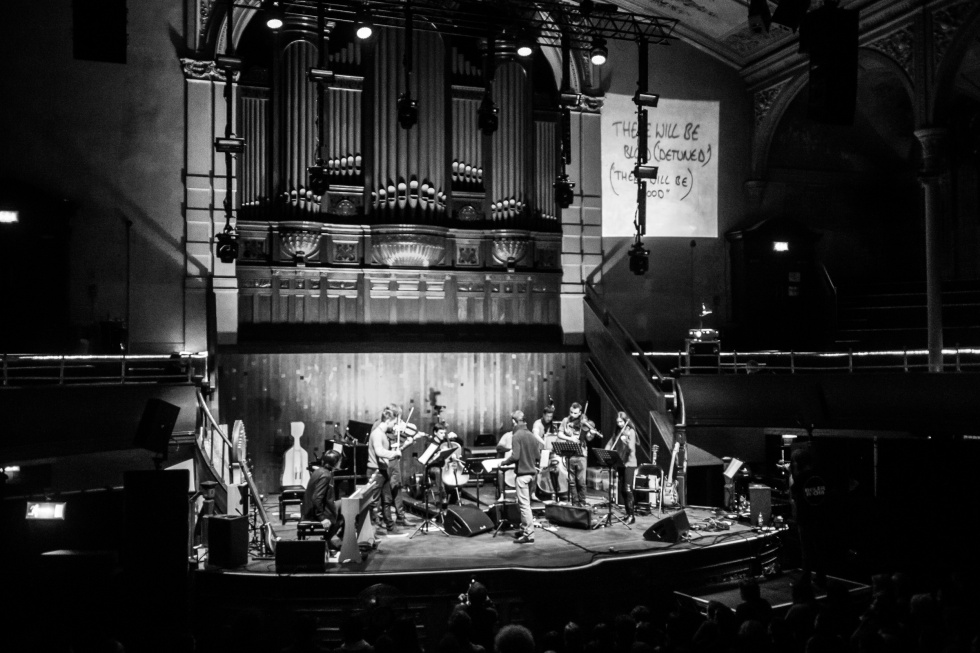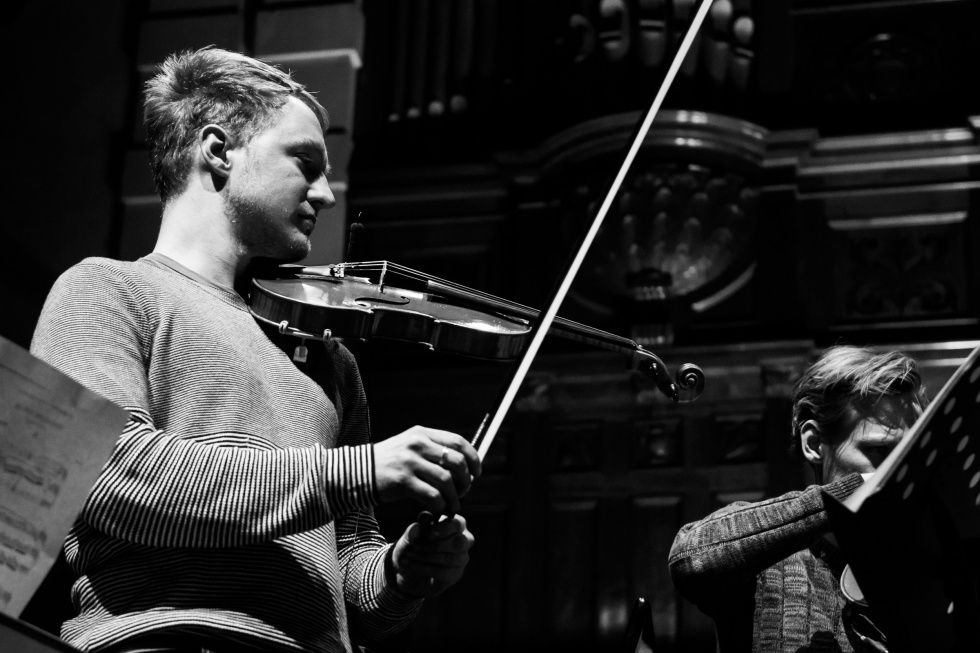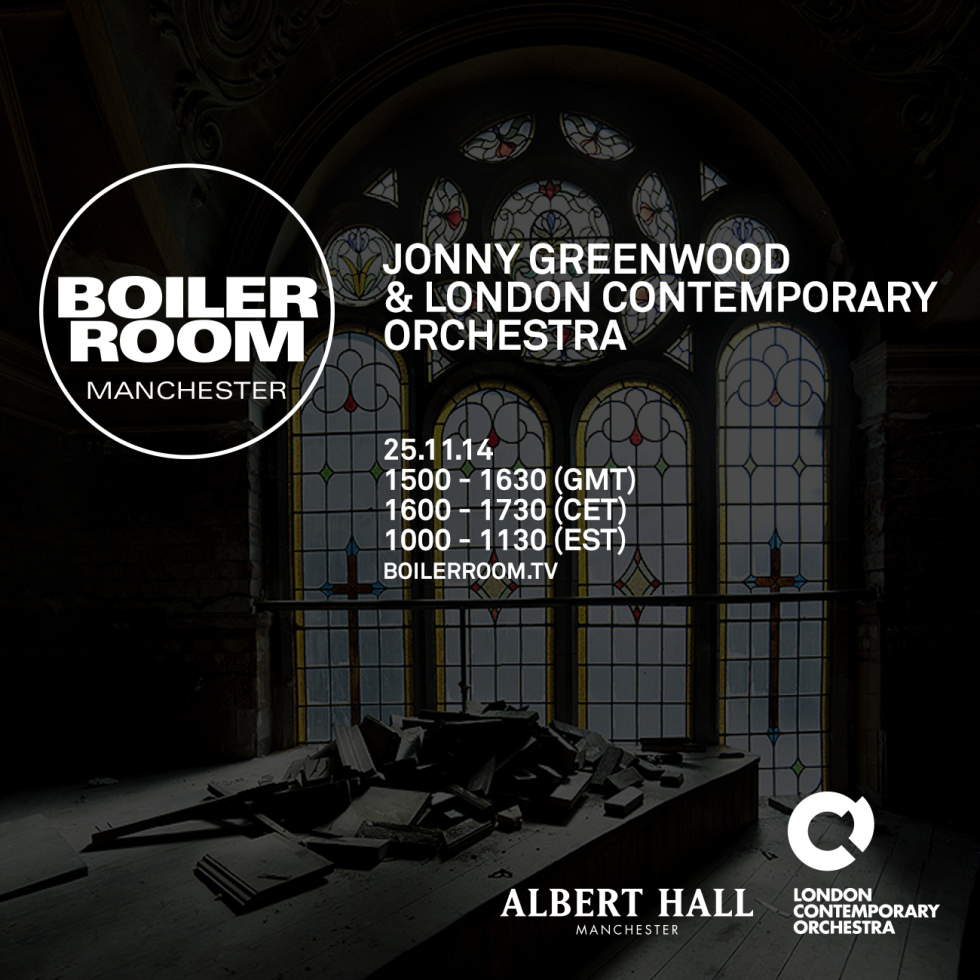
At a classical concert, it’s usually expected that the audience is receptive, passive and even reverential. But Jonny Greenwood and the London Contemporary Orchestra (LCO) soloists want something different.
For their show at Manchester’s Albert Hall, the audience were free to move as they liked and, continuing an idea used at previous performances, were invited to join in on their mobile phones during Greenwood’s “Self Portrait with Seven Fingers”.
Chris Woolfrey, a journalist hand-picked by Greenwood himself, spoke at length to the Radiohead guitarist five days after the show, asking for impressions. He’d debuted a new piece and performed several excerpts from his widely acclaimed original film scores, alongside pieces written by others, and selected by him and the LCO – all of which will be rebroadcast and archived by Boiler Room (head HERE for more on that).
Greenwood recalls, “I felt really high afterwards. Lots of things just seemed to work. Not necessarily the pieces, but the idea of playing them like that. What was good – all these little four or five minutes pieces, and all this faffing around in between, it allowed the audience to talk to each other.” This built on something he’d said a few hours before the concert: “There are things that people don’t like, and I find it really interesting that you can have that sort of reaction straight away, with certain things not going down well.”
Greenwood and the LCO soloists would encourage the audience to make that feeling known, perhaps, and it’s the aspect of the collaboration between the LCO and Greenwood that often gets picked up on; that they’re trying to remove some of the barriers associated with classical music. These barriers exist, explained the LCO’s co-founder Robert Ames, because classical music “got lost somewhere along the way”.
He continued: “It became classical music and it wasn’t the popular music any more. At the same time, the attitudes around it changed as well…not being able to cough, having to be in one seat all the time. That’s far removed from how performances were in the past. You had people cheering, and chamber music being done in beer halls and people drinking and clapping before a piece had finished.”
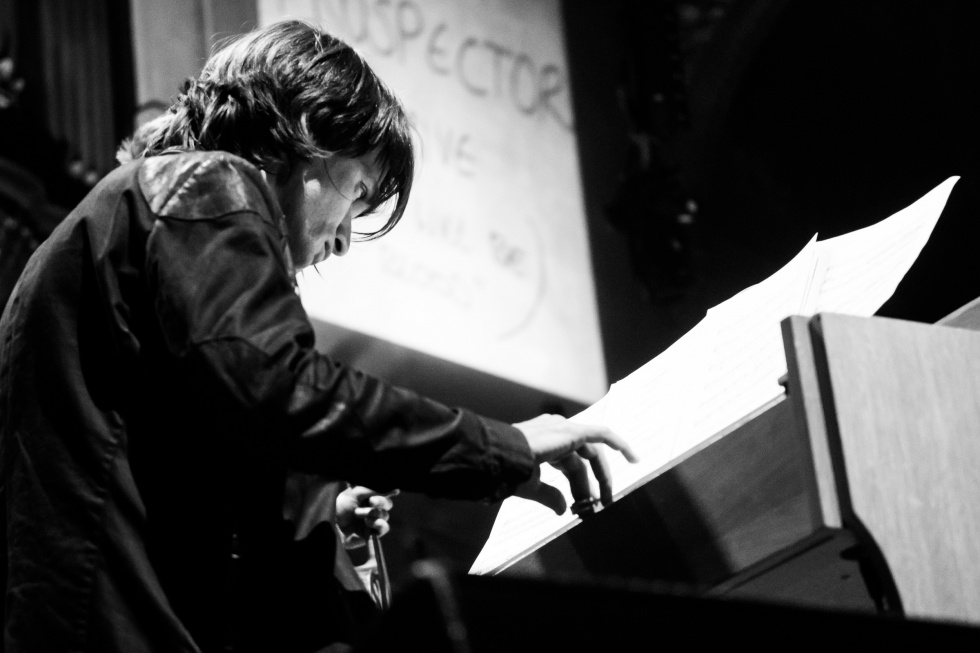
Greenwood made his name in a different environment, largely performing to crowds who use silence to signify a lack of appreciation. During the conversation with Ames, Greenwood added: “I remember an early music teacher – we were doing this Mendelssohn thing and he said ‘I hate Mendelssohn, it’s all awful.’
“I thought ‘You can’t say that!’ but of course you’re allowed to have these opinions, and it’s quite liberating to not just talk about the things you like but encounter things you don’t get on with and take exception to them. We’ll do things tonight that they either find boring or gratingly off-putting on their ears. Hence the bar, and the room to go and hide in for five minutes.”
“It’s exciting, things can go wrong. It’s precarious. I hope that comes across.”
As it was, the event went down very well with the crowd – who seemed to welcome the freedom to move from the stalls to the seats upstairs, and also to try out different parts of the venue’s upper ring. One of the pieces performed was “Industry“, a Michael Gordon work for solo cello. Oliver Coates’ playing was distorted beyond recognition, his solo filling the space with a soaring, engine-like back-and-forth on the cello’s strings. The audience loved it.
Many of Greenwood’s own compositions were less intrusive: the beautiful “Application 45 Version 1” bridged the set, calling forth the disconcertingly inoffensive silhouettes of Joaquin Phoenix and Philip Seymour Hoffman in Paul Thomas Anderson’s movie The Master, which Greenwood scored.
His pieces did that throughout the night; evoking images, and not always the images associated with the film scores. This is a notable characteristic of Greenwood’s music – you get a sense that on some level, it’s speaking to you.
We wanted to ask Greenwood about this directly: does he set out to imbue not only a sense of visuals but also narrative from his pieces? Although his work goes into quite experimental worlds it remains very accessible – like hearing a story being told.
Greenwood had typically thoughtful opinions on the idea. “That’s interesting”, he said. “I hope so. I’m beginning to understand now what music teachers would drum into us at school about something being said; it’s music and notes, but it’s a conversation as well. I always thought that was a bit of a primary school idea: a bit wet, a bit soft. But they don’t have to be saying nice things. There’s more than one way of talking. And I guess that’s hopefully how the music would work.”
“It’s really interesting to me that music can be much longer, and can have a bigger scale behind it. And I think that starts to happen when you think of it as something being said, instead of just a thing that’s sort of catchy, or surprising.”
A potential part of the reason for that feeling in his music is his fondness for voice-like instruments: the violin, the viola and the curious ondes martenot. They have incredibly strong emotional qualities, similar to a human voice; and Greenwood is used to providing music for Thom Yorke, one of the most recognisable and emotionally resonant voices in modern music. Perhaps it’s writing in that way – thinking of a voice – that makes his work successful. Greenwood agreed that, when he writes for orchestra, his working practices aren’t necessarily different from when he’s working with Radiohead.
“I suppose I’m still steeped in the idea of chords and melodies,” he said. “A chord and, you know, a song being sung. That’s kind of how I’ve always worked. The tension comes from trying to work out how to do that with non-standard chords and melodies. I’m so used to having a chord sequence, and there being a song written to it, that I suppose I’ve still got one foot in that camp a little bit.”
But there’s something else going on. When asked about his interest in performing live with the LCO, he said: “It’s exciting, things can go wrong. It’s precarious. I hope that comes across.”
Precarious. Greenwood wants to put life into his music, to make it fragile and uncertain. That fragility does make it very lively and, to the extent that this is possible in music, gives it human qualities. It speaks to you – creates abstract narratives in your head, and denotes images to put with them.
Expanding on that idea, he said: “I’m starting to enjoy things that take their time; have a big scale to them. I’m wary of just doing lots of music that runs out of ideas after a minute or two minutes. It’s really interesting to me that music can be much longer, and can have a bigger scale behind it. I think that starts to happen when you think of it as something being said, instead of just a thing that’s sort of catchy, or surprising.”
Greenwood picks up on that sense of precariousness often – as if it might be what fuels his writing. He talks about it in relation to his work with the LCO but also when performing with Radiohead, and contrasts it with his own perceived flaws in the production of recorded material.
“I think that’s why I listen to more and more electronic stuff; because I’m just not satisfied with how acoustic things sound through speakers, really.”
“I’m so used to so much music that begins with the push of a button, and is reliably going to sound like the last time you pressed that button. And that’s fine, and can be great if it’s good recorded music, but it’s very interesting to me when there’s none of that – when there’s nothing reliable about it, other than how people are going to play in the end.”
As an artist who made his name in the recorded world, it’s an interesting development. So why is recorded music troubling him?
“Electronic music is great coming out of speakers, and acoustic music, like this, is great coming off a stage. It’s only when you start using microphones and trying to reproduce acoustic sounds that too much gets lost and it becomes a big compromise. I think that’s why I listen to more and more electronic stuff; because I’m just not satisfied with how acoustic things sound through speakers, really.”
Greenwood is preoccupied by transmission, and by reception. After the concert, when asked again about the idea, he said: “It’s a funny old problem. There’s a book that we all read, about ten or fifteen years ago – everyone in the band passed it around, got obsessed with it – called Repeated Takes.
It talks about how when they first started recording singers, even Caruso and that era, the technicians got together and were saying to each other ‘Well, how do we accurately do this? Should we record from a distance, because then the speakers are going to be replacing the space in the room, and the microphone that we’re using? What’s a proper reproduction of somebody’s voice?’”
How far can a recording embody reality, and how far should it? Greenwood argues that the question makes for “an interesting process when you’re trying to record acoustic things, but also adds a kind of fog between you and the music.”
Being an opportunity to showcase both recorded and so far unrecorded compositions, this idea is at the heart of the live collaboration between Greenwood and the LCO. Plenty of recorded music is very powerful, but live performances can often be more so. Greenwood put this across when discussing one of his great influences, the composer Krzysztof Penderecki. He comprehensively studied the use of electronics in music, Greenwood explained, and “then decided he could get all the same sounds out of an orchestra, so he turned his back on it and then went to an orchestra and said ‘Well, we can do white noise, and we can do all of these effects and sounds, and they’re going to be more interesting.’
“And he’s right, you know: there is nothing like hearing 48 string players generating white noise. It’s far more interesting than a synthesiser.”
Head straight through to the Jonny Greenwood & The London Contemporary Orchestra session here. Thanks again to Chris Woolfrey. Next February, Jonny will play alongside the LCO Soloists for his first hometown show in 14 years – tickets + info over here.
